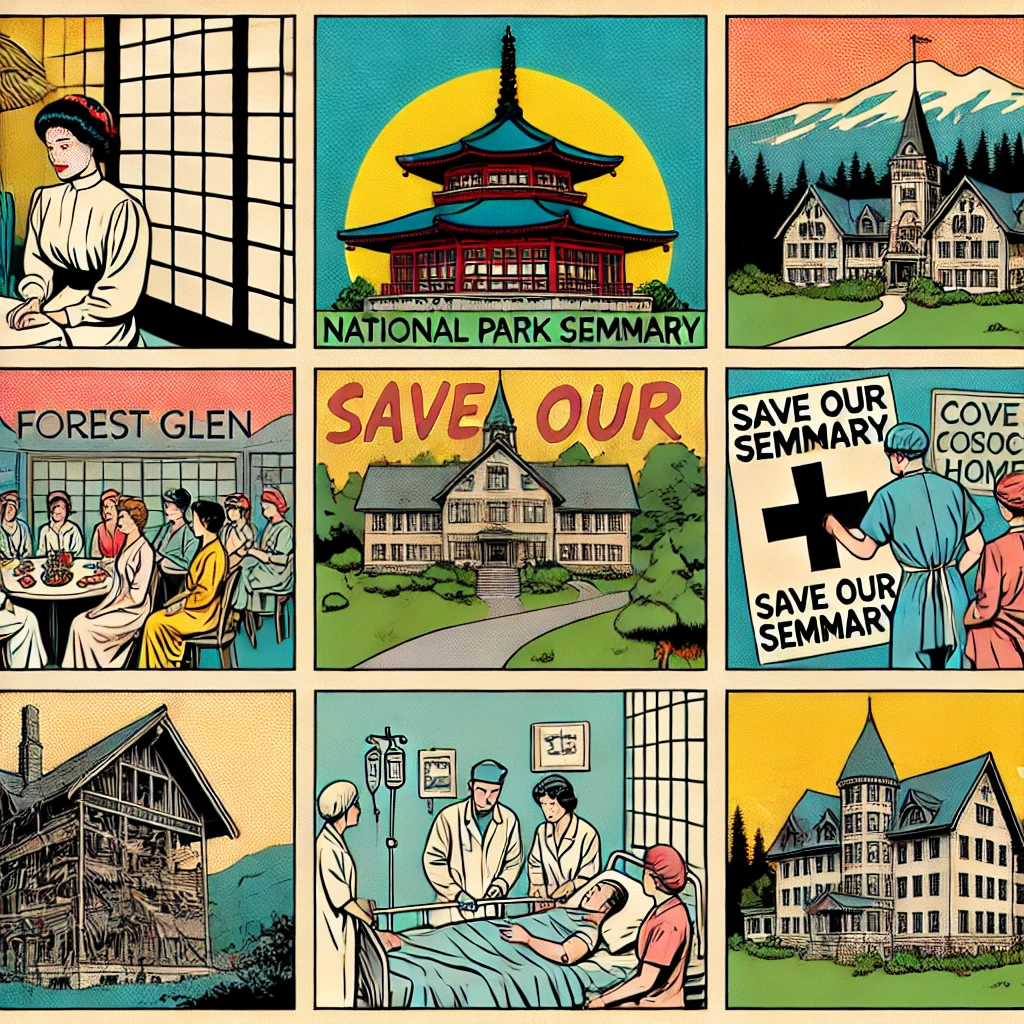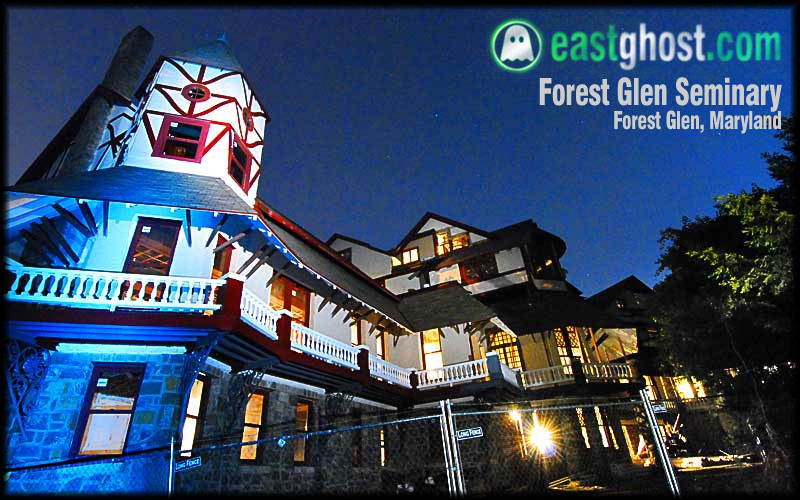Forest Glen Backstories
Many things to many people over many decades
(aka Walter Reed Army Medical Annex): Formerly an elite girls academy. Inside 495 beltway, near Mormon temple, on Linden Lane. Sports Maryland’s only Japanese Pagoda (ca. 1904) along with 32 other extraordinary buildings dating from late two centuries ago. Entirely spooky.
Originally the “Forest Inn” hotel, then the “National Park Seminary” elite women’s finishing academy, later a seriously-wounded soldier treatment & war convalescence campus, then a medical research annex, now under renovation. Tons of unusual history in this place, in Montgomery county, right under the Mormons’ noses.
EXCELLENT HISTORY https://saveourseminary.org
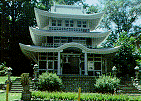
Twenty years ago, the U.S. Army abandoned a former Maryland girls’ fancy finishing school, the Seminary at Forest Glen. Once the Walter Reed medical annex in DC near the Mormon temple, its sylvan grounds are bisected by a ravine with a hidden grotto. Maryland’s only authentic Japanese pagoda is present (ca. 1904) along with a Swiss chalet, an Italian villa, a Dutch windmill, and a stone castle, among other most unexpected finds.
Excellent http://www.operant.com/seminary/
Ye Forest Inne in late 1800’s.
It was used by the Army as a convalescence “home” for recovering soldiers in WWII.
32 acres. 29 buildings, 25 of which are historic.
Latest plan as of Jan 2005 is to develop the site into mixed residential and historic. See SOS
13 Oct 1999: A $147 million, 475,000 square-foot laboratory, which will provide research in biological and chemical toxicology as well as preventive, topical, and combat casualty medicine, was dedicated at the Walter Reed Army Medical Center Forest Glen Annex on October 5. –http://www.montgomerycountymd.gov/mc/news/press/99-362.htmlSatellite:

—–History:
Forgotten, But Not Lost // by Christian Moen // Apr. 5, 2002

A garden path leads to the Italian villa
Scattered around a wooded, 30-acre campus in Montgomery County, Md., 33 architecturally eclectic buildings fit together as if assembled by the designers of a miniature-golf course. A Gothic castle, a windmill, a pagoda, and other structures that have withstood several incarnations as educational institutions over the first half of the 20th century today sit empty. The Forest Glen Annex of Walter Reed Medical Center is silent except for the distant rush of cars on the Captial Beltway.
Originally built as a seminary, or finishing school for women, the U.S. Army has owned this piece of land and everything on it for 60 years, but for half that time its ownership was in name in only. The toll from years of neglect is clear: Wood has rotted, statues are broken or missing, and stucco has buckled under its own weight, slowly pulling window frames with it.
Spurred on by a preservation organization called Save Our Seminary, residents have spent almost two decades outraged at the Army’s oversight of Forest Glen. Talk of transferring ownership of the National Register-listed property has floated around for years, but the Army didn’t take steps in that direction until two years ago.
In the fall of 2000, the Army officially “excessed” Forest Glen, declaring it surplus property and handing it over to the Government Services Administration (GSA), which acts as the real-estate agent for federal buildings. Before any federal property can be put on the open market, however, GSA must first contact federal agencies, state and county governments, and homeless services, offering each a chance to take over.

Pagoda
So far, no agency has been willing to take on the costly renovations that would be a necessary part of the deal. The property is now being offered for public-benefit use, such as education, GSA’s last stage before putting it on the open market. This time there may be some takers.
“About a dozen schools had expressed interest before they saw it,” says Bonnie Rosenthal, the executive director of Save Our Seminary. “Then the number dropped to four once they saw it.”
Since its founding in 1988, Rosenthal’s organization has patrolled the property and reported damage and theft to the Army. But reporting damage is not the same as repairing it, and while the Army decided what to do with the property, the deterioration and repair costs escalated.
After a fire in 1993 claimed the school’s theater, Save Our Seminary and the National Trust for Historic Preservation took the Army to court in an attempt to end the neglect. The court ruled in 1996 that although the seminary was in bad shape, the Army was doing the best it could to maintain it.
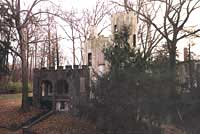
Castle
Based on a 1995 study, any reuse of the property would have a negative return because of steep restoration costs. A followup study determined that it would cost $9.8 million to stabilize just the buildings that are in the worst shape.
The four organizations that are still interested in buying the seminary, according to Rosenthal, are Takoma Academy, St. Albans School, the French International School, and an organization called Forest Glen Commonwealth. GSA will put it for sale on the open market this summer.
“Takoma Academy is probably the most capable and likely candidate,” says Rosenthal says. “They have the greatest need, and they have the funding.” Also, she notes, they are the only organization that is interested in the entire property.
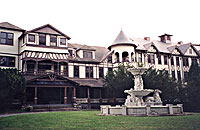
The inn, the seminary’s oldest structure.
In 1887, an inn became the first building on the site, but the resort’s distance from Washington—too far for a quick trip and not far enough to be worth a train ride—made it fail.
The National Park Seminary, a school that prepared the daughters of America’s wealthiest families for a life of privilege, opened in 1894. Its strength lay in its rural setting and increasingly exotic architecture. The school’s founders used different building styles to stimulate young ladies’ imaginations and show them an abridged version of the world. Through the years, other directors added their own flourishes to the grounds.
Army Takeover
When the Army took over in 1942, the campus was known as National Park College, a successful junior college. Invoking the War Powers Act, the Army bought the college for $800,000, auctioned off everything it didn’t need, and used the rural campus as a peaceful setting for veterans to recover from the horrors of war. The Forest Glen Annex of the Walter Reed Army Medical Center soon became the nation’s leading prosthesis lab, serving much the same purpose through the Vietnam War. Soon after, the Army built a new campus on Georgia Avenue in Washington, D.C., and kept only a skeleton crew at Forest Glen.
Rosenthal says that her organization prefers a private developer with a plan for a mix of residential and commercial uses because they fear the impact that 1,500 students might have on the neighborhood. “Imagine cars coming and going twice a day,” she says, although she concedes that Save Our Seminary must be flexible. Worse than traffic, though, is the possibility that no school receives federal endorsement and no private developer wants the property.
“What happens if there is no interest at all?” Rosenthal asks. “Then the GSA will have to reconsider what to do with it. Return it to the Army? Parcel it up? If it reaches that point, it will be beyond the point of restoration.”
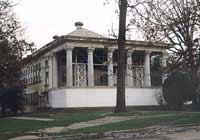
Gymnasium
After so many years of struggling to save the place, she says, the group also wants the public to have access to facilities such as the gym, the ballroom, and the chapel.
As early as June, Rosenthal and all the members of Save Our Seminary, and anyone else who has wandered dreamily among the Greek revival temple’s caryatids, may finally know what the future holds for the Italian villa, the pagoda, and the rest of the buildings that have been left to fend for themselves. Whether Forest Glen returns to its origins as a place of education or becomes a place to live and shop, one thing is for sure: After two decades, they are closer than ever to saving the seminary.
Christian Moen is an associate editor of Smithsonian magazine.
Guided walking tours of the seminary take place at 1 p.m. every fourth Saturday from March to November. No reservations are required. For more information, contact Save Our Seminary at (301) 495-9079.
http://www.nationaltrust.org/magazine/archives/arch_story/040502.htm
—
What is the National Park Seminary?
The National Park Seminary is a historic district in the Forest Glen area of Silver Spring, MD, which includes a wooded glen and two dozen Victorian era buildings, including a magnificent 3-story ballroom, a windmill, castle, and Japanese pagoda.
The first building, “Ye Forest Inne,” was constructed in 1887. Early suburban developers acquired the land above Rock Creek, laid out lots, and built the hotel to attract prospective homeowners. By 1894, the hotel failed and the inn was converted to a women’s post-secondary school. For nearly 50 years, the National Park Seminary and College was one of the most prestigious women’s schools in the country. As enrollment grew, so did the campus, and the new buildings, built in various international styles, reflected the educational philosophy of founders and the values of a nation just emerging on the international scene. The school weathered the Great Depression and, just as it was beginning to thrive again, it was taken over by the U.S. Army in 1942, when it served as a rehabilitation center for wounded veterans returning from World War II, Korea, and Vietnam.
Many suburban resort hotels were built in the late 1800’s. Many of them were converted to schools. And many of them were, in turn, taken over by the armed forces during the war. But very few of these original resort hotels are left, and none that have witnessed all three incarnations! Clearly this site has profound architectural and historical importance. It is also a place of pure magic – a commodity very hard to come by today.
—
Council suggests master plan for Forest Glen seminary land by Jackie Mah Special to The Gazette July 18, 2001 Zoning guidelines could help developers A County Council committee took a closer look Monday at the county’s role in determining the disposition of the National Park Seminary in Forest Glen. The committee agreed to begin establishing a master plan “envelope” of zoning criteria, including acceptable uses and density of construction, through the Montgomery County Planning Board. The aim is to keep the seminary, which contains many historic buildings featuring unusual architectural styles, from meeting an undesirable future. The Army declared the seminary as surplus property in 1991, after the Walter Reed Medical Center rehabilitation facilities were relocated to the hospital’s main campus. However it wasn’t until now, 10 years later, that the Army finally gave the property to the General Services Administration of the federal government for sale. By law the GSA had to first offer the property to other federal agencies, but was unsuccessful in receiving any bids from that sector. The county’s turn to be offered the property could come as early as in the next couple of months, and it would have 20 days to make a decision. It was made clear at the committee meeting that County Executive Douglas M. Duncan is against the county purchasing the site. “The executive doesn’t want the county to be involved in it at all,” said council spokesman Patrick Lacefield after the meeting. However, during the meeting of the Planning, Housing and Economic Development committee, Councilman Derick Berlage (D-Dist. 5) of Silver Spring said he would like to see the GSA give the county an extension on the official 20-day deciding period to think through the purchase more thoroughly. “What I want to see happen is for the federal government to give the county an option for the next two years,” Berlage said. However, besides Duncan’s and Berlage’s opinions, the council on the whole does not have a stated position on what to do with the seminary yet, Lacefield said. “We’re only now approaching the time where it makes a difference what we think.” But to Peggy Gervasi, president of Save Our Seminary, the council’s implied message is that the county wants to see the land put to good use but is unwilling to get too involved in the process. “So far they’re saying all the right things, but they’re not doing the right things — so far,” Gervasi said. “Today was a step in the right direction.” Gervasi said SOS’s point is not to save all the buildings in the seminary. “We’re not naive,” she said. However, they do support plans that will not harm the existing environment. “A local developer has come forward with a plan that we like,” she said. “It’s a mixed-use development that is primarily residential. A large component of it is senior housing, which works for us because it’s very low-impact because they don’t really drive cars.” That plan also includes public use of a Gothic-style ballroom and the glen. An Adaptive Reuse Study came out in 1995 and looked at four different scenarios for the future use of the property: all-residential, all-retirement, an unspecified institutional use, and all-residential including an additional 11 acres the Army was then thinking of selling as a bonus with the seminary. Gervasi expressed cautious approval for those general ideas, especially for the all-residential scenarios, which she said were the most feasible concepts. “As the basic starting document, it was fine,” Gervasi said, though she called it “unimaginative.” The seminary is located five minutes from the Forest Glen Metro stop, on the grounds of the Forest Glen Annex of Walter Reed Army Medical Center in Silver Spring. The site, which has been home to various business endeavors including a hotel, casino and women’s finishing school since the 1800s, is now a historic menagerie comprised of a Dutch windmill, a Japanese pagoda and an English castle, among other unusual structures.
—
Historic Maryland Site Awaits Recycling Into Housing Over 114 years, the National Park Seminary has been a hotel, school and convalescent home. Most of the buildings are to be restored. Stephen Manning Los Angeles Times April 25, 2004 SILVER SPRING, Md. — With a mini-village inhabited by a pagoda, windmill, castle and the hulking remains of a 19th century hotel, the National Park Seminary looks a bit like a theme park for adults. Up close, however, it’s clear that the abandoned site near the Capital Beltway is missing the theme-park tidiness of a fantasy land. Stones on the castle have crumbled away, paint peels off the windmill and a sign on the boarded-up hotel warns of asbestos. During its 114-year life span, the 32-acre site has been a resort for summer-weary Washingtonians, a finishing school for girls and a convalescent home for injured soldiers. But it has been largely abandoned in the last few decades, falling victim to decay and neglect. The seminary will begin life anew this year. After decades of trying to find a new use for the site, a builder selected by Montgomery County will preserve the 25 historic buildings and convert them to housing. “Something is finally happening and what is happening looks good,” said Bonnie Rosenthal, a member of the group called Save Our Seminary, which worked to protect the buildings. A Wisconsin-based developer will spend $80 million to convert the property and a nearby field into 255 units of homes, condominiums and apartments. The Alexander Co. hopes to break ground within nine months, and the first residents could move in by 2006. “When we look at the site, we see a fabulous opportunity for housing,” said Natalie Bock, development property manager for Alexander. Listed on the National Register of Historic Places, the seminary sits on a leafy hillside next to the Walter Reed Army Hospital Annex and overlooks the Capital Beltway. It was first developed as a hotel, opening in 1890 as a relatively rural retreat for city dwellers. But it quickly failed and, in 1894, was converted into a school known as the National Park Seminary. The school built an eclectic jumble of buildings around the original hotel, including an assortment of sorority houses that reflected architecture from different parts of the world. It added a ballroom, chapel and dotted the grounds with sculptures. In 1942, the Army absorbed the seminary into Walter Reed and used it to house injured World War II soldiers. It continued to use some of the buildings as office space, but by the mid-1990s, most of the buildings sat empty and boarded up. The Army showed little interest in preserving the space, and the buildings began to crumble from water damage. Fire destroyed a playhouse, and vandals spirited away stained-glass windows and statues. “They [Army officials] haven’t really been the best stewards of the historical property,” said Lisa Rother, a Montgomery County planner who worked on the project. “We are working against time to stabilize these buildings.” Under an agreement with the Army, the county will buy the seminary and then sell it to Alexander, Rother said. Alexander plans to restore the site with the help of builders Eakin / Youngentob of Arlington, Va., and Baltimore-based Struever Bros., Eccles & Rouse. The developers plan to build about 90 homes in a field across the street, the sale of which will help finance restoration of the older buildings. The hotel will probably be converted to apartments, some of which will be designated as affordable housing. Buildings such as the gym will be made into condominiums, Bock said. The sororities, including the pagoda, will be turned into single-family homes. “The pagoda would be a funky place to live,” she said. “In every market here are some people who want to live in a unique living environment.” Because the site is listed on the National Register, much of the work will have to be approved by the county’s historical preservation commission and the Maryland Historical Trust. That means, if possible, original windows and building materials must remain, Bock said. In some cases, that may be difficult. Extensive water damage has collapsed some roofs and floors. Bock said some buildings, such as a dormitory that used to house senior seminary students, may have to be scrapped. Members of Save Our Seminary accept that some buildings may not be salvageable. But they are thrilled to have the restoration underway, even if it means an influx of about 300 new neighbors to their quiet community. “We’re realistic,” Rosenthal said. “This will increase the value of the whole area.”
—
Groups express interest in seminary E-Mail This Article by David Fishlowitz Staff Writer Dec. 5, 2001 Private schools, colleges want to use historic structures Several private schools, colleges and non-profit groups have expressed interest in acquiring property within the National Seminary Historic District in Forest Glen, which includes 29 buildings — some with unusual architecture — on 32 acres formerly owned by the Army. The property is on the Montgomery County Master Plan for Historic Preservation and was once a girls’ finishing school. The buildings include a windmill and a pagoda, and preservationists have long argued that the property deserves to be saved. The seminary is now in the control of the federal General Services Administration, which is marketing to groups who can use it for public purposes, said Park and Planning Silver Spring team leader Glenn Kreger. The architecture and setting make the property distinct, said Bonnie Rosenthal, a member of Save Our Seminary, a group whose purpose is to preserve the historic area. “It is a potpourri of building types,” Rosenthal said. “To find a collection of such variety of styles is unusual. And putting it in such a charming landscape setting.” “Right now, [GSA is] in the public conveyance process,” Kreger said. “We have received letters of response from 12 educational institutions. There was a tour for groups that responded to the offer Nov. 15. They have until March 1 to submit formal applications.” Currently, 10 groups have expressed interest: French International School in Bethesda; Takoma Academy in Takoma Park; University of the District of Columbia; Sidwell Friends School in Bethesda; Forest Glen Commonwealth in Kensington; Association for Retarded Citizens in Silver Spring; St. Albans School in the District; Jewish Primary Day School in Silver Spring; Logos Evangelical Seminary Institute in Silver Spring; and Southeastern University in the District. The French International School wants to consolidate its three campuses at the seminary, said Don Anderson, director of the office of American affairs at the school. “It’s been a dream of the school to move the whole campus,” Anderson said. “To find a property large enough in the Washington Metropolitan area is not a given. We’ve had a lot of constraints looking for a site.” The French International School, a non-denominational private school, has 1,150 students, Anderson said. Anderson added that the school would not use the entire seminary property. Takoma Academy is planning to pool its financial resources with Columbia Union College and Adventist Health Care to acquire the seminary, said Principal Larry Kromann. “This is a huge project,” Kromann said. “It takes all of us working together to adequately utilize it.” Takoma Academy’s Board of Trustees has authorized funds and may merge with Sligo Elementary, an affiliated school, to bring a K-12 program to the seminary, Kromann said. Columbia Union College would hold adult evening classes, Kromann said. Currently, architects are determining feasibility, Kromann said. “They are looking at the condition of the buildings, what can be housed,” Kromann said. “We don’t know how much renovation will be required.” The groups must agree to use the area for educational purposes for 30 years to get public conveyance, Kreger said. Due to the great expense of renovating the site while simultaneously preserving the historic district, it might take a multi-group effort, Kreger said. “I wouldn’t be surprised if some of them wanted to combine their efforts,” Kreger said. GSA has 18 months to market the property before the Army regains control, said Scott Reilly, assistant chief Administrative Officer with Montgomery County Government. “It is a long, complex process for federal agencies to dispose of property,” Reilly said. First, GSA has to see if other federal agencies are interested in the property. Then, any homeless services, including evaluation by Housing and Urban Development or a homeless service provider. “We are fully committed to make sure homeless services remain on the site when reuse is accomplished,” Reilly said, referring to the current Carroll House on the property. Then, it must be offered to local and state governments under “discounted conveyance,” which means it would have to remain in public hands. After that, it would be offered without strings at market value to the public. Finally, GSA would market it to private entities on a competitive basis. “The county is looking for an economically viable use not dependent on public subsidies,” Reilly said. “Also, to preserve the historic part and keep compatible to surrounding neighbors. We want to keep homeless services and park areas.” The property is located one mile from the Forest Glen Metro Station, adjacent to the Forest Glen Annex of the Walter Reed Army Medical Center near Rock Creek Park and Linden Lane. The Army has owned the property for the past 10 years and has been slow to move, said Walter Booth, a resident and former member of the Forest Glen Historic Preservation Committee. “It seems like 10 years ago if they didn’t want it, they should have turned it over to GSA,” Booth said. “The Army has been trying to get rid of it for 10 years,” Reilly said. Since the Army has withdrawn its members, the site has become hazardous, Booth said. “When they moved out, it seriously affected vandalism,” Booth said. “Doors are now barred and there has been an increase in crime.” Redeveloping the area is difficult due to the small, narrow roads, Booth said. “Construction would increase traffic density on narrow, small roads,” Booth said. “Developers want to knock down the whole thing, but residents don’t want it. I think it’s a matter of compromise. Save the best things and figure out how to handle the roads.”
—
Walter Reed Army Medical Center’s Forest Glen section is located in Silver Spring, Md., approximately four miles north of the main post. Forest Glen has a land area of 164 acres. It includes a contemporary area, adjacent to a mixed commercial district, and a historic district located in the wooded area that borders the Capital Beltway (I-495).
The contemporary area is home to the Walter reed Army Institute of Research and Naval Medical Research Institute. Forest Glen also includes a large outdoor recreation and picnic area, child development center, a fabric care facility, the motor pool, installation support functions, and a modern shopping complex. The shopping center includes a post exchange, commissary, clothing sales store, bowling alley, arts and crafts shop and Fisher House. The shopping complex serves not only Walter Reed and National Naval medical Center service members, but much of the large retired military community of greater Washington.
The historic district is located on a 27-acre parcel of land called the National Park Seminary Historic District. The department of the Army has declared this property excess, pending transfer to the General Services Administration to find a new owner. This district was once an exclusive private “finishing school” for young women. The buildings have a unique collection of architecture styles, including a Dutch windmill, Swiss chalet, Japanese pagoda, an Italian villa and an English castle.
—The History of the Site Most people who are familiar with the National Park Seminary Historic District don’t know it by that name; most know it as the former convalescent hospital on the north-side of the Forest Glen Annex of the Walter Reed Army Medical Center (WRAMC). A Long, Rich History Before the U.S. Army The U.S. Army has been occupying the site known as the Forest Glen Annex only since 1942, when the federal government acquired the property from private ownership under the War Powers Act. The historic buildings on the northern tip of the Annex had been a thriving women’s college (1937-1942) and before that it was prestigious finishing school that started before the turn of the last century (1894-1936). Earlier still (1887-1894), it had been a short-lived hotel and casino, part of a Victorian-era land development scheme. And the history of Forest Glen stretches far further back than that. During the Civil War, the land was ownd by a southern sympathizer, whose name was Alfred Ray.. The troops of Confederate Jubal Early were permitted by Ray to camp on his land, before Early led his troops down nearby Brookeville Road for their unsuccessful raid on Washington, D.C. Ray spend time in a federal prison for this action. The land originally was part of a huge tract that belonged to the Carroll family. John and Daniel Carroll were both influential men on the national level back in colonial days;John founded the first catholic church in Maryland, walking distance from the site. Daniel Carroll was a politician, heavily involved in the nascent District of Columbia. They lived very near to the Forest Glen site. National Park Seminary, a finishing school for the nation’s elite, flourished in the “roaring twenties.” National Longevity Resource Center Honoring veterans and personnel from WRAMC The WRAMC Era When America became involved in WWII in the European theater, Walter Reed Army Medical Center (WRAMC) needed more space for returning vets who needed long-term convalesence and rehab. So the Army exerted its authority under the War Powers Act and effectively took over the women’s college in 1942. WRAMC Annex at Forest Glen served the wounded from 1942 through 1977, when the last patient was moved out. Most of the activity was centered on prosthetics, audiology, speech therapy, and rehab. The USO brought in big talent in WWII and the Red Cross sent many volunteers. Put the cursor on the doctor’s bag to learn at a Project to honor the Vets & Caregivers of the WRAMC Annex era. When the Army bought the school, it picked up over 100 addiitional acres that had been an operating dairy farm and former tobacco plantation. That huge parcel will remain WRAMC property and it now houses the Commissary, recreational facilities and a contemporary research lab. This part of the Annex is to the south of the property that had been used as a convalescent hospital. Around 1970, anticipating that the old school property would no longer needed in the WRAMC system (as a new hospital was being built downtown and scheduled for completion in 1977), the Army made it known that it wanted to raze the historic buildings to build an incinerator. In response to that prospect, Montgomery County and other authorities had the property listed on the National Register of Historic Places with the Department of the Interior/National Park Service. This action effectively blocked the Army from destroying the buildings, but as they became unwanted by 1980, neglect and vandalism started to take an alarming toll on the place. In the late 1990s, U.S. Senator Paul Sarbanes managed to direct some appropriated funds to the site for site stabilization (some new roofing and downspouts, to tighten the “envelopes” of the structures that had sustained water damage). In 1999, the Army let it be known that it was beginning to take formal steps to “excess” the area known as the “National Park Seminary Historic District.” In late 1999, the Forest Glen Commonwealth, Inc. was formed, in order to help bring a renaissance to this neglect landmark.
